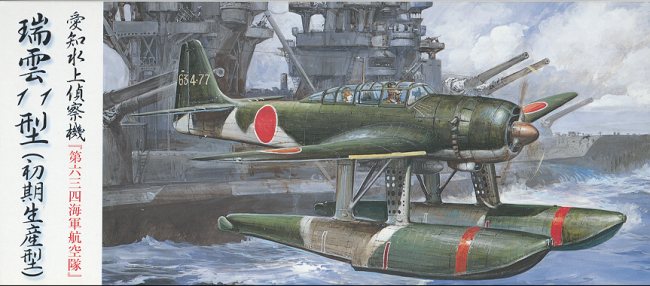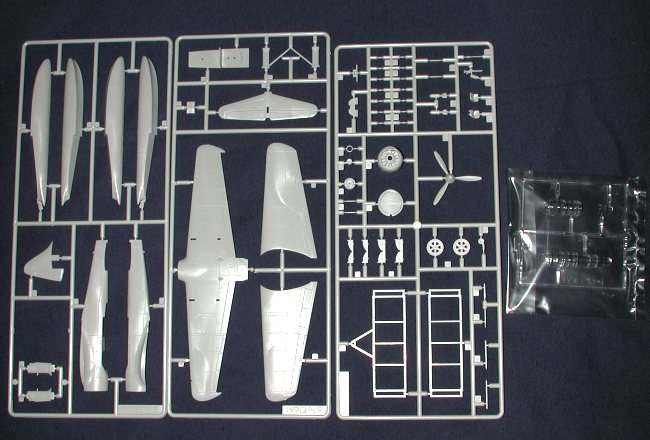
|
KIT: |
Fujimi 1/72 E16A1 'Paul' |
|
KIT # |
C-14 |
|
PRICE: |
$39.98 |
|
DECALS: |
One aircraft |
|
REVIEW & |
|
|
NOTES: |
|

|
HISTORY |
Considering that the Japanese Navy had to range over a vast amount of territory, most of which had no airfields, it is not unusual that a large number of floatplanes and flying boats were designed for the IJN. In fact, more reconnaissance floatplanes were designed for the Navy than any other type.
The E16A1 Zuiun was finished in May of 1942 and had wood wing tips and tailplane, though the rest of the aircraft was aluminum. It's 1,300 hp Mitsubishi Kinsei 51 radial gave the E16A1 a maximum speed of about 270 mph. Armament consisted of two 7.7mm guns in the wings and one in the aft cockpit. The wings folded to allow stowage aboard seaplane tenders. A rather unique trait was the inclusion of dive brakes in the forward float struts so the E16A1 could be used as a dive bomber.
Production aircraft replaced the wing 7.7mm guns with 20mm cannon and the rear gun with a 13mm variety. The plane was stressed to carry a 250 kg bomb under the fuselage.By the time the Zuiun reached operational status in 1944, Japan had lost air superiority. Those units sent to the Philippines suffered heavy losses and were generally ineffective. The majority of airframes were expended in suicide missions at Okinawa. Only three Kokutais operated the Zuiun; the 301st, 634th and Yokosuka Kokutais. A total of 256 aircraft were built, and I believe that one is held as part of the Silver Hill collection.
|
THE KIT |

If there was a 'standard' Fujimi WWII kit, then this follows that pattern. It has nicely engraved and detailed panel lines, no flash, and a minimal cockpit. Instruments are engraved and there is some detail on the fuselage sides. Options are limited to a couple of underwing bombs and a canopy option of either fully closed or one with the rear gunner's position open.
 As one would expect from a
floatplane model, quite a bit of plastic is devoted to a beaching trolley.
Engine detail is quite good and is molded as part of the engine cowling. This
aircraft used ejector exhausts and each one of those tiny things is a separate
molding. Keeping them out of the clutches of the carpet monster will be a really
good trick! The one thing I would change is not to have the holes for the lower
wing bomb racks opened for us. I would like the choice of having a clean wing or
not.
As one would expect from a
floatplane model, quite a bit of plastic is devoted to a beaching trolley.
Engine detail is quite good and is molded as part of the engine cowling. This
aircraft used ejector exhausts and each one of those tiny things is a separate
molding. Keeping them out of the clutches of the carpet monster will be a really
good trick! The one thing I would change is not to have the holes for the lower
wing bomb racks opened for us. I would like the choice of having a clean wing or
not.
The instruction sheet consists of 11 steps, each logical in sequence and giving the necessary color callouts in each step. All Zuiuns were painted exactly the same, with dark green uppers and light grey undersides with a yellow IFF band at the leading edge of the inner wing. Decals are sufficient to allow you to model one of five aircraft from the 301st and 634th Kokutais. You get two sheets, one with the white backgrounds and the other with the red or yellow lettering. Like all Japanese decals, these are a bit thick, but if applied using warm water should give excellent results.
The kit looks like it is very nice and should build into a super model. However, at a $40 dollar US retail price, it really is way overpriced for what you get. I can only hope that you can find one on sale as I did for a more reasonable price.
|
REFERENCES |
Japanese Aircraft of the Pacific War, by Rene J Francillon, 1979 (2nd Edition), Putnam
Review kit courtesy of me and my wallet!
If you would like your product reviewed fairly and quickly by a site that has over 1,500 visits a day, please contact me or see other details in the Note to Contributors.
Back to the Previews Index Page